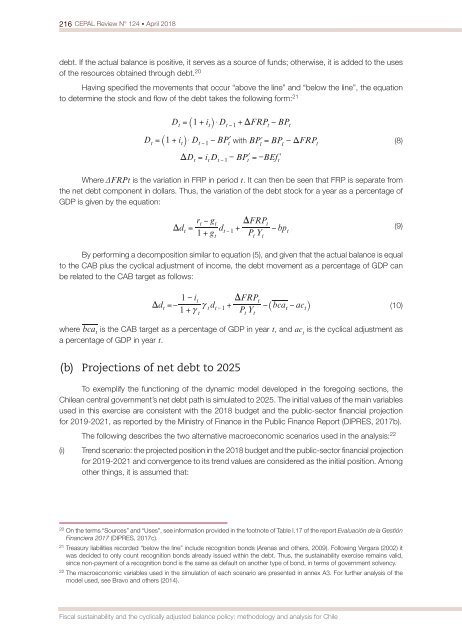CEPAL Review no. 124
April 2018
April 2018
Create successful ePaper yourself
Turn your PDF publications into a flip-book with our unique Google optimized e-Paper software.
216 <strong>CEPAL</strong> <strong>Review</strong> N° <strong>124</strong> • April 2018<br />
debt. If the actual balance is positive, it serves as a source of funds; otherwise, it is added to the uses<br />
of the resources obtained through debt. 20<br />
Having specified the movements that occur “above the line” and “below the line”, the equation<br />
to determine the stock and flow of the debt takes the following form: 21<br />
with (8)<br />
Where ΔFRPt is the variation in FRP in period t. It can then be seen that FRP is separate from<br />
the net debt component in dollars. Thus, the variation of the debt stock for a year as a percentage of<br />
GDP is given by the equation:<br />
(9)<br />
By performing a decomposition similar to equation (5), and given that the actual balance is equal<br />
to the CAB plus the cyclical adjustment of income, the debt movement as a percentage of GDP can<br />
be related to the CAB target as follows:<br />
(10)<br />
where is the CAB target as a percentage of GDP in year t, and ac t<br />
is the cyclical adjustment as<br />
a percentage of GDP in year t.<br />
(b) Projections of net debt to 2025<br />
To exemplify the functioning of the dynamic model developed in the foregoing sections, the<br />
Chilean central government’s net debt path is simulated to 2025. The initial values of the main variables<br />
used in this exercise are consistent with the 2018 budget and the public-sector financial projection<br />
for 2019-2021, as reported by the Ministry of Finance in the Public Finance Report (DIPRES, 2017b).<br />
(i)<br />
The following describes the two alternative macroeco<strong>no</strong>mic scenarios used in the analysis: 22<br />
Trend scenario: the projected position in the 2018 budget and the public-sector financial projection<br />
for 2019-2021 and convergence to its trend values are considered as the initial position. Among<br />
other things, it is assumed that:<br />
20<br />
On the terms “Sources” and “Uses”, see information provided in the foot<strong>no</strong>te of Table I.17 of the report Evaluación de la Gestión<br />
Financiera 2017 (DIPRES, 2017c).<br />
21<br />
Treasury liabilities recorded “below the line” include recognition bonds (Arenas and others, 2009). Following Vergara (2002) it<br />
was decided to only count recognition bonds already issued within the debt. Thus, the sustainability exercise remains valid,<br />
since <strong>no</strong>n-payment of a recognition bond is the same as default on a<strong>no</strong>ther type of bond, in terms of government solvency.<br />
22<br />
The macroeco<strong>no</strong>mic variables used in the simulation of each scenario are presented in annex A3. For further analysis of the<br />
model used, see Bravo and others (2014).<br />
Fiscal sustainability and the cyclically adjusted balance policy: methodology and analysis for Chile


















